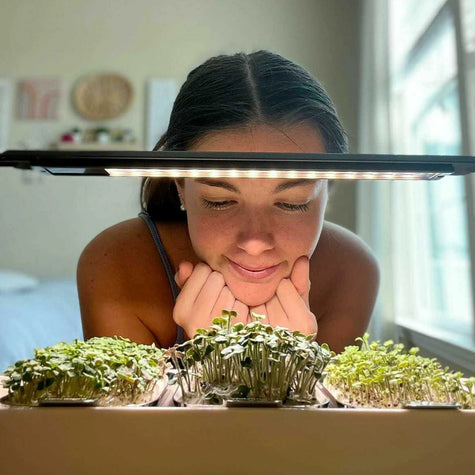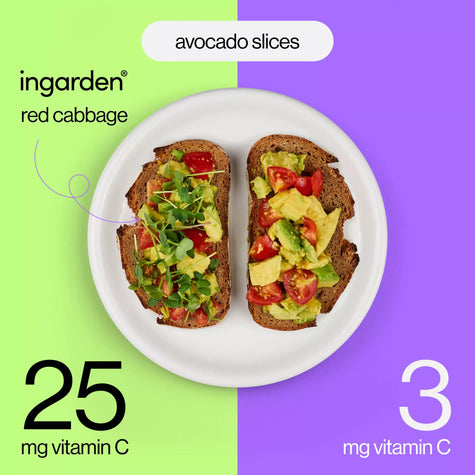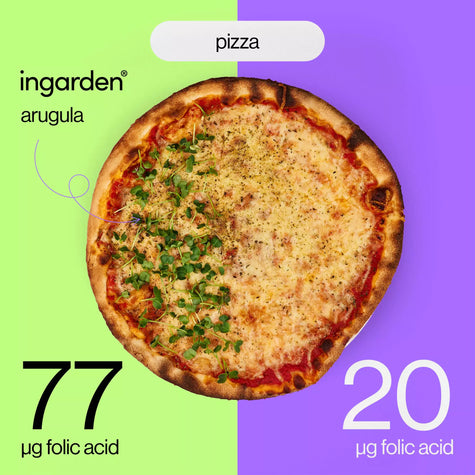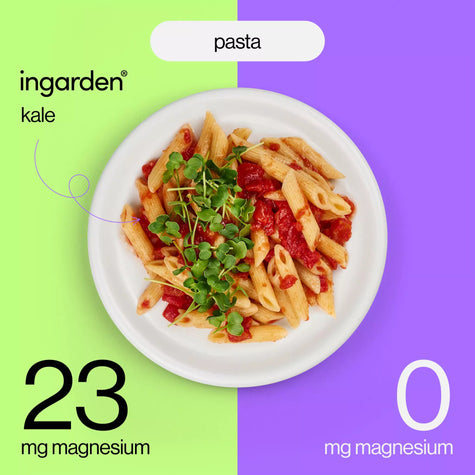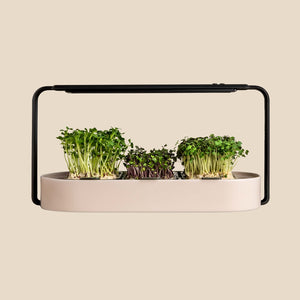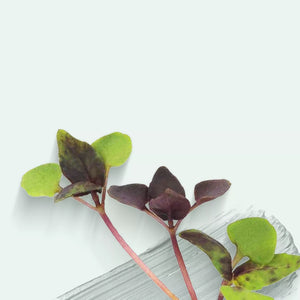The Benefits of Kale Microgreens
Boost immune system
Support gut health
Support eye health
Anti-inflammatory properties
Lowered cholesterol
Kale microgreens are a delicious and nutrient-packed superfood that can be conveniently grown in the comfort of your own home, all year round. There are numerous compelling reasons to incorporate kale microgreens into your diet, such as their exceptional health benefits and effortless cultivation. Growing these tiny superfoods is a straightforward and gratifying way to enhance your overall well-being and embrace a healthier lifestyle.
Written by Mariana, Founder of ingarden - 19th of April, 2023.
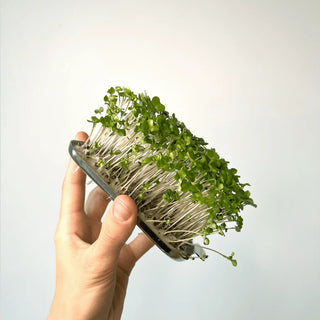
1) Kale Microgreens have anti-inflammatory properties
Kale microgreens have been shown to have anti-inflammatory properties, which is one of the reasons they're touted as a superfood. Chronic inflammation has been linked to a number of health problems, including heart disease, diabetes, and cancer. By reducing inflammation, consuming kale microgreens may help lower the risk of these conditions.
Kale microgreens are particularly rich in antioxidants like flavonoids, carotenoids, and vitamin C. Antioxidants are compounds that can help neutralize harmful molecules called free radicals, which can contribute to inflammation and damage cells in the body.
Another factor that may contribute to the anti-inflammatory properties of kale microgreens is their high levels of glucosinolates. Glucosinolates are a group of compounds that are found in cruciferous vegetables like kale, broccoli, and cabbage. When you eat cruciferous vegetables, glucosinolates are broken down into other compounds, including sulforaphane. Sulforaphane has been shown to have anti-inflammatory effects in both animal and human studies.
By incorporating kale microgreens into your diet, you may be able to lower your risk of chronic inflammation-related health problems and enjoy improved overall health.

2) Kale Microgreens boost immune sytem
Kale microgreens are packed with nutrients that support a healthy immune system. These nutrients include vitamins A, C, and K, as well as minerals like calcium and potassium.
Vitamin A is important for immune function because it helps regulate the immune response and support the production of white blood cells. White blood cells are the cells of the immune system that are responsible for fighting off infections and diseases.
Vitamin C is also important for immune function because it helps support the production of white blood cells and acts as an antioxidant to protect against oxidative stress.
Vitamin K is another important nutrient for immune function, as it helps support blood clotting and wound healing.
In addition to these vitamins, kale microgreens also contain minerals like calcium and potassium, which are important for immune function. Calcium is essential for the production and activation of white blood cells, while potassium helps regulate fluid balance and support the health of cells throughout the body.
Overall, consuming kale microgreens is a great way to support immune function and protect against infections and diseases.
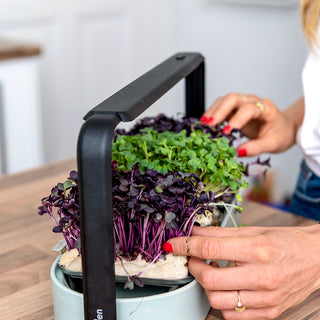
3) Kale Microgreens support eye health
Kale microgreens are a rich source of nutrients that are important for eye health. These nutrients include vitamins A and C, which are essential for maintaining healthy vision.
Vitamin A is important for eye health because it helps protect the surface of the eye and maintain healthy vision. It is also essential for the production of rhodopsin, a pigment that is important for low-light vision.
In addition to vitamin A, kale microgreens are also a great source of vitamin C. Vitamin C is important for eye health because it helps protect against cataracts, a condition that can cause clouding of the lens in the eye and lead to vision loss. By consuming enough vitamin C through foods like kale microgreens, you may be able to reduce your risk of developing cataracts and maintain healthy vision as you age.
Kale microgreens also contain lutein and zeaxanthin, two powerful antioxidants that are important for eye health. These antioxidants help protect the eyes against damage from free radicals, which can contribute to the development of age-related macular degeneration, a leading cause of vision loss in older adults.
Overall, consuming kale microgreens is a great way to support healthy vision.
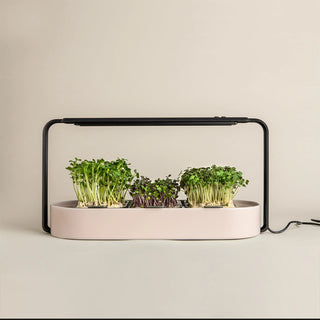
4) Kale Microgreens support lower cholesterol
High cholesterol is a common health problem that can increase the risk of heart disease and stroke. Fortunately, consuming kale microgreens may help lower cholesterol levels and reduce the risk of these conditions.
One way that kale microgreens may help lower cholesterol levels is through their high fiber content. Kale microgreens are a rich source of dietary fiber, which can help reduce LDL or "bad" cholesterol levels. LDL cholesterol is the type of cholesterol that is most strongly linked to heart disease, and reducing its levels can have a number of health benefits.
In addition to fiber, kale microgreens also contain compounds that may help lower cholesterol levels. Finally, kale microgreens are also a rich source of omega-3 fatty acids. Omega-3s are a type of healthy fat that have been shown to have a number of health benefits, including helping to reduce inflammation and improve heart health.
Overall, consuming kale microgreens is a great way to support heart health and lower cholesterol levels.

5) Kale Microgreens aid with digestive health
Digestive health is essential for overall wellbeing, and consuming a diet rich in fiber and nutrients can help promote healthy digestion. The fiber in kale microgreens is primarily made up of insoluble fiber. Insoluble fiber does not dissolve in water and passes through the digestive system largely intact. This can help add bulk to stools and promote regularity.
Fiber is an important nutrient for digestive health because it helps to regulate bowel movements and prevent constipation. Consuming a diet rich in fiber has been linked to a reduced risk of colon cancer and other digestive disorders.
Overall, incorporating kale microgreens into your diet can be a simple and effective way to promote digestive health and reduce inflammation in the gut.

Build your own kale growing kit in 3 steps
Choose your ingarden color🎨 Choose what fits your style best
Select your plan📦 Buy one-off, on a subscription or in bulk!
Choose your Kale Microgreens 🌱go for Kale Microgreens or find some other superfood that boosts your health and maximizes flavor
ingarden's Kale Microgreens Nutritional Analysis
ingarden has conducted the most comprehensive analysis to date. Our analysis sheds light on the impressive health benefits of kale microgreens, making them an excellent addition to any diet. Be sure to check out the complete nutritional breakdown below.

Kale Microgreens Nutrient Facts
Bright green and slightly curled leaves encapsulate the mild-sweet flavor.
Contains plenty of ...
- Manganese: for stress, energy, bones, and connective tissue
- Vitamin C: for the immune system, energy metabolism, and nervous system
- Folic Acid: for homocysteine metabolism, mental function, immune system, reduction of tiredness/fatigue, and cell division
- Vitamin K1: for blood clotting, bone, and tooth structure
Kale Microgreens: A Complete Nutritional Breakdown
| daily recommended dose | kale | |
|---|---|---|
| Vitamin B8 (Biotin) | 30μg | 1.89μg (6%) |
| Vitamin C | 95mg | 15.3mg (16%) |
| Vitamin E | 12mg | 0.08mg (1%) |
| Vitamin K1 | 60μg | 9.11μg (15%) |
| Folate | 300μg | 33.8μg (11%) |
| Choline | 400mg | 18.5mg (5%) |
| Calcium | 700mg | 36mg (5%) |
| Iron | 10mg | 0.51mg (5%) |
| Magnesium | 300mg | 23mg (8%) |
| Manganese | 2mg | 0.6mg (30%) |
| Lutein | 6mg | 1.94mg (32%) |
Key Findings
Compared to 100g raw supermarket kale*, 100g organic kale microgreens from ingarden contain:
- 3600% more choline
| daily recommended dose | arugula | |
|---|---|---|
| Vitamin B8 (Biotin) | 30μg | 5.15μg (17%) |
| Vitamin C | 95mg | 11mg (12%) |
| Vitamin E | 12mg | 0.33mg (3%) |
| Vitamin K1 | 60μg | 17.2μg (29%) |
| Folate | 300μg | 57.4μg (19%) |
| Choline | 400mg | 17.3mg (4%) |
| Calcium | 700mg | 42mg (6%) |
| Iron | 10mg | 2.2mg (22%) |
| Magnesium | 300mg | 33mg (11%) |
| Manganese | 2mg | 0.74mg (37%) |
| Lutein | 6mg | 4.42mg (74%) |
Key Findings
Compared to 100g raw supermarket arugula*, 100g organic arugula microgreens from ingarden contain:
- 131% more manganese
- 51% more iron
- 24% more lutein
- 13% more choline
| daily recommended dose | broccoli | |
|---|---|---|
| Vitamin B8 (Biotin) | 30μg | 2.62μg (9%) |
| Vitamin C | 95mg | 24.1mg (25%) |
| Vitamin E | 12mg | 0.25mg (2%) |
| Vitamin K1 | 60μg | 36.5μg (61%) |
| Folate | 300μg | 33.1μg (11%) |
| Choline | 400mg | 31.3mg (8%) |
| Calcium | 700mg | 65mg (9%) |
| Iron | 10mg | 0.73mg (7%) |
| Magnesium | 300mg | 45mg (15%) |
| Manganese | 2mg | 0.7mg (35%) |
| Lutein | 6mg | 1.98mg (33%) |
Key Findings
Compared to 100g raw supermarket broccoli*, 100g organic broccoli microgreens from ingarden contain:
- 255% more manganese
- 166% more lutein
- 114% more magnesium
- 67% more choline
- 41% more calcium
| daily recommended dose | mustard | |
|---|---|---|
| Vitamin B8 (Biotin) | 30μg | 7.24μg (24%) |
| Vitamin C | 95mg | 9.36mg (10%) |
| Vitamin E | 12mg | 0.204mg (2%) |
| Vitamin K1 | 60μg | 11.2μg (19%) |
| Folate | 300μg | 33.1μg (11%) |
| Choline | 400mg | 60.8mg (15%) |
| Calcium | 700mg | 38mg (5%) |
| Iron | 10mg | 0.95mg (10%) |
| Magnesium | 300mg | 31mg (10%) |
| Manganese | 2mg | 0.44mg (22%) |
| Lutein | 6mg | 0.89mg (15%) |
Key Findings
Compared to 100g prepared yellow mustard*, 100g organic mustard microgreens from ingarden contain:
- 2240% more vitamin C
- 673% more lutein
- 373% more folate
- 171% more choline
| daily recommended dose | radish | |
|---|---|---|
| Vitamin B8 (Biotin) | 30μg | 2.88μg (10%) |
| Vitamin C | 95mg | 14.6mg (15%) |
| Vitamin E | 12mg | 0.58mg (5%) |
| Vitamin K1 | 60μg | 61.4μg (102%) |
| Folate | 300μg | 39.6μg (13%) |
| Choline | 400mg | 20.9mg (5%) |
| Calcium | 700mg | 32mg (5%) |
| Iron | 10mg | 0.48mg (5%) |
| Magnesium | 300mg | 33mg (11%) |
| Manganese | 2mg | 0.47mg (24%) |
| Lutein | 6mg | 3mg (50%) |
Key Findings
Compared to 100g raw supermarket radish*, 100g organic radish microgreens from ingarden contain:
- 29900% more lutein
- 5700% more vitamin E
- 4623% more vitamin K1
- 581% more manganese
- 230% more magnesium
- 222% more choline
- 58% more folate
- 41% more iron
- 28% more calcium
| daily recommended dose | red cabbage | |
|---|---|---|
| Vitamin B8 (Biotin) | 30μg | 4.79μg (16%) |
| Vitamin C | 95mg | 21.7mg (23%) |
| Vitamin E | 12mg | 1.32mg (11%) |
| Vitamin K1 | 60μg | 15.9μg (27%) |
| Folate | 300μg | 55.8μg (19%) |
| Choline | 400mg | 53.1mg (13%) |
| Calcium | 700mg | 120mg (17%) |
| Iron | 10mg | 0.76mg (8%) |
| Magnesium | 300mg | 38mg (13%) |
| Manganese | 2mg | 0.37mg (19%) |
| Lutein | 6mg | 0.99mg (17%) |
Key Findings
Compared to 100g raw supermarket red cabbage*, 100g organic red cabbage microgreens from ingarden contain:
- 1100% more vitamin E
- 287% more calcium
- 219% more biotin
- 211% more choline
- 210% more folate
- 204% more iron
- 201% more lutein
- 186% more magnesium
- 20% more manganese
We weren't satisfied with traditional supplements, just disappointed.
So we found something better: Microgreens. This nutrient-rich alternative provides your body with the essential vitamins and minerals it needs and is organically grown without genetic modification or artificial flavors. Simply add them to any dish as a source of nutrients and flavor.
Mariana & Christian
Founders of ingarden
Grow completely in water. Harvest weekly.

1. Place three pads

2. Pour water

3. Press the button
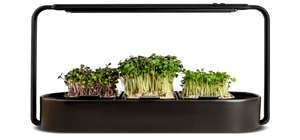
4. Set up in 2 minutes and harvested in 7 days!
Are you interested in more scientific studies about microgreen health benefits?
From the moment I discovered the remarkable health benefits of microgreens in scientific research, I was utterly fascinated. The abundance of nutrients and life-giving properties packed into these tiny plants left me amazed. That's why my passion for growing microgreens at home was born. Our ingardens enable people to tap into the power of these remarkable little plants, experiencing the joy and satisfaction of growing their own fresh and nutritious food.
Frequently asked questions about Kale Microgreens
Yes, you can eat kale microgreens! In fact, they are a popular ingredient in salads, spreads, smoothies, and other dishes. These microgreens are not only delicious but also highly nutritious, containing a range of vitamins, minerals, and antioxidants. However, it's important to note that while kale microgreens are generally safe to eat, you should always wash them thoroughly before consuming them to remove any dirt, bacteria, or pesticides that may be present if they are store-bought. Additionally, if you have any allergies or medical conditions, it's always a good idea to consult with a healthcare professional before adding new foods to your diet.
Be sure to check out our recipes for more inspiration.
Growing Kale Microgreens is a simple and rewarding process that can be done in the comfort of your own home. Here are the steps to grow your own superfoods indoors:
- Choose a growing container: these healthy greens can be grown in a wide variety of containers, such as plastic trays, seedling flats, or even recycled plastic containers. Make sure the container is at least 2 inches deep and has drainage holes at the bottom. You could also use a hydroponic system like ingarden to avoid using soil and overwatering your plants.
- Prepare the soil: fill the container with a sterile seed starting mix or potting soil. Moisten the soil by spraying it with water until it is damp but not soaking wet.
- Sow the seeds: scatter the kale evenly over the soil surface. You don't need to cover the seeds with soil, as they need light to germinate.
- Water the seeds: use a spray bottle to mist the seeds and soil gently. Be careful not to overwater, as this can cause the seeds to rot.
- Cover the container: place a clear plastic lid or plastic wrap over the container to create a humid environment that helps the seeds germinate. Remove the cover once the seeds have sprouted.
- Provide light: place the container in a bright area or under grow lights.
- Water regularly: keep the soil moist by misting it with water daily. Avoid overwatering, as this can lead to mold growth.
- Harvest: Once the kale microgreens are 1-3 inches tall, they are ready to harvest. Cut the stems just above the soil surface using scissors or a sharp knife.
It is advisable to use specific kale microgreen seeds, as they germinate quicker and yield better results than regular broccoli seeds.
ingarden's seeds come from the region of Emilia Romagna in Italy as well as the Netherlands. ingarden seeds are strictly from trusted and certified organic growers, meaning our seeds are confirmed organic by accredited authorities who check that no artificial fertilizers, herbicides, or pesticides are used.
Every batch of seeds is tested by laboratories for their microbiological safety according to HACCP standards. All seed batches are tested for germination rates guaranteed at 90%, as well as for their look and integrity. The seeds are only handled by certified organic manufacturers who avoid cross-contamination and maintain the highest standards of hygiene.
Many people think microgreens and sprouts are the same thing, but they are not. Of course, they both have something in common, but there are also many differences.
Sprouts are seedlings from seeds that have not yet developed roots and have not yet completed photosynthesis. Sprouts, on the other hand, are plants that have already developed roots and are therefore larger than shoots.
Microgreens are small-leafed plantlets that are usually used as toppings for soups, salads, or other dishes. They have a very intense flavor and often also a special color. While sprouts are often eaten at a very early germination time, microgreens have more time to grow and more time to develop nutrients and flavor. For this to succeed, microgreens need either soil or a corresponding mat of flow from which the nutrients can be drawn, as well as water and sunlight, of course. Microgreens are then harvested a little later after about 5-7 days and eaten without the root. The flavor of microgreens is much more intense than sprouts, and the nutrient content is many times higher.
Microgreens are young, tender plants grown from seeds and typically harvested within 1-2 weeks. Although they are small, they are packed with nutrients and have an intense aroma and flavor.
It is possible to incorporate these tiny superfoods into a balanced diet, but it is unlikely that they can replace an adequate amount of vegetables.
Vegetables provide many nutrients, including fiber, vitamins, minerals, and phytonutrients that are important for health. While microgreens contain some of these nutrients in higher concentrations than mature plants, they typically lack fiber and a broader nutrient profile.
If you want to replace vegetables with microgreens, you should make sure to use a variety of types to ensure that you get a broader nutrient profile. It is also important to incorporate other sources of fiber, such as whole grains, legumes, and fruits, into your diet.
Overall, microgreens can be a healthy addition to a balanced diet, but they should not be used as a substitute for vegetables.
Grow the freshest, healthiest microgreens any time of the year

The information provided on this site is for educational purposes only, and is not a substitute for professional medical advice. Always seek your physicians' or qualified nutritionists' advice before using any information to treat or prevent any medical condition.
